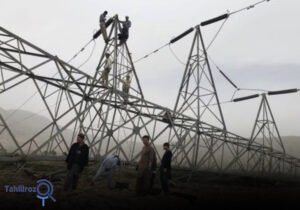During the past few days, some Taliban officials have confirmed and announced that the plan to settle and transfer members of the Tehrik-e Taliban Pakistan members (TTP members) and Pakistani immigrants from the outskirts of the Durand border to the northern provinces and some central regions of Afghanistan has been finalized and is possible. This plan will be implemented in the future.
Although the Taliban have not provided a logical and justified reason for taking this decision and the only claim they have made is that this decision was taken based on the common interests of Afghanistan and Pakistan, but analysts believe that these are the demands of the Pakistani government from the Taliban.
Because after TTP members settled in the border areas of the Durand border, their movements and attacks has increased inside Pakistan, and it has created a wave of unrest in Pakistan, which the Pakistani army, despite numerous attacks against members of Tehreek-e-Taliban Pakistan even in the eastern provinces of Afghanistan, have failed to prevent and control these riots and unrest.
Anyway, apart from who ordered this plan or who demanded it, now the important question here is that what are the goals of the implementation of this plan and what will be the consequences?
Here, we are trying to calculate the goals and consequences of this plan for Afghanistan according to the available evidence and examine the benefits and losses of this issue.
Waziristan immigrants and TTP members
The Waziristan refugees who are now living on the outskirts of the Durand border, are those who were forced to flee following the unrest in the Waziristan regions of Pakistan and migrated to the eastern provinces of Afghanistan.
These immigrants are generally Pashtuns who have strong ethnic and tribal relations with families on both sides of the border.
The majority of these immigrants have bought land and built houses in the eastern provinces of Afghanistan. During the past years, the majority of them have turned to agriculture and livestock.
During the last two decades, these immigrants did not pose any threat to the government of Pakistan, or any challenge to the government of Afghanistan.
However, with the collapse of the republic and the Taliban’s dominance over Afghanistan, more than four thousand members of the Pakistani Taliban settled in the eastern provinces of Afghanistan and exactly in the same areas where the Waziristan immigrants lived.
The settling and relocation of TTP members in these areas caused the Pakistani government to consider the Afghan Taliban as supporters of the Pakistani Taliban, and following these accusations and suspicions, the Pakistan government officials directly and indirectly attacked the Afghan Taliban. They warned and sometimes gave good and bad advice, but there was no visible result.
In this regard, Sirajuddin Haqqani, the head of the Haqqani network and currently the interior minister of Afghanistan, held a round of negotiations between the Pakistani Taliban and the government of this country due to his popularity among the Waziristan immigrants and members of the Pakistani Taliban.
Although these negotiations led to two rounds of ceasefire, they ended without results. After the conclusion of the negotiations between the Tehreek-e-Taliban and the government of Pakistan, the attacks of this group against the government forces increased and caused huge human and financial losses to Pakistan.
The increase in the attacks of Tehreek-e-Taliban Pakistan and also the failure of the Pakistani army towards this group, caused that on February 22, 2023 a high-ranking Pakistani delegation led by Defense Minister Khawaja Muhammad Asif and also General Nadeem Anjum, Director General of Inter-Services Intelligence (ISI) together with other high-ranking officials of the Pakistani government, entered Kabul with a warning message and met Mullah Abdul Ghani Baradar and other Taliban officials.
Although the media and the press made different stories about the Pakistani delegation’s visit to Kabul, but according to the analysts, the security officials of Pakistan had explicitly requested the cooperation of the Afghan Taliban to prevent and neutralize the attacks of the Pakistani Taliban in that country. The answer of the Taliban has certainly been positive.
In other words, the Taliban have asked Pakistan for money to transfer TTP members and a number of Waziristan immigrants living in the outskirts of Durand to the northern provinces and parts of the central regions.

Objectives of transferring TTP members to the north of the country
However, it is not yet clear how many Waziristan immigrants and how many TTP members will be transferred to which places by the Taliban and what issues the future plans of the Taliban will focus on in this regard. Because the Taliban has briefly and vaguely confirmed that the plan to transfer TTP members to the northern provinces and central regions has been finalized.
Of course, it is not possible to draw clear and specific conclusions from these vague words, and on the other hand, one cannot rely on the analyzes and opinions of observers and analysts.
However, it is likely that the Taliban will pursue the following goals from this transfer and relocation:
1) Changing the demographic structure of the north of the country
Most of the inhabitants of the northern provinces of Afghanistan are Tajiks, Uzbeks and Hazaras. The center of gravity of power of non-Pashtun ethnic groups is in the northern provinces of the country. For this reason, throughout modern history, the non-Pashtun ethnic groups, which have been ignored by the Kabul government, have mostly been able to create serious challenges for the Kabul government from the north.
Since the time of Amanullah Khan in 1301(solar year) until the previous era of the Taliban, the sovereignty of Kabul has always been challenged from the north. Due to this issue, the Taliban are now trying to overcome this challenge forever by changing the population structure of northern Afghanistan.
2) Implementation of the regulation of settlers
Due to the riots and unrest that were always started by the non-Pashtun tribes from the north of Afghanistan against the tyrannical rulers of Kabul, the regulation of settlers was approved in 1922 in 12 articles.
In plain language, that regulation was a written plan for the settlement and transfer of Pashtuns from the eastern regions to the northern provinces of the country.
As a result of the approval of this regulation of settlers, many fertile lands in northern Afghanistan were handed over to the Pashtuns, and the native inhabitants of some areas moved to other places.
This constitution is a long-term and sustainable plan to break the ethnic barriers that can continue.
3) Pashtunization of society
The change in the demographic structure and the continued implementation of the carrier system will ultimately lead to the collapse of the centralized powers of non-Pashtuns and on the other hand, with the expansion of the Pashtun population throughout the northern regions, the power of the Pashtuns will increase more than ever and due to the expansion Population in all regions, Pashtuns can easily cover the whole country.

Consequences of the transfer of TTP members to the northern provinces
For many years, the fighters of TTP have made the fate of Waziristan regions of Pakistan extremely restless and chaotic. The constant battles of disguise.
The second consequence that exists without a doubt is the emergence of conflicts and insoluble disagreements between native residents and settlers.
Because according to the past experience and what has happened before, in many areas where Waziristan immigrants have moved, there have been wars and conflicts between the immigrants and the local residents for many years.
On the other hand, due to the fact that many terrorist groups are active in the northern regions of Afghanistan, it is possible that TTP fighters, by establishing relations with these groups, will create greater unrest and chaos and cause bigger headaches. to create
Apart from the worrisome consequences that were mentioned, there are also deeper questions and concerns. For example, in which areas may the Taliban transfer TTP fighters and Waziristan immigrants, and what will happen to the indigenous people and the original residents of those areas.
What will happen if Pashto warriors merge with native and helpless Persian speakers. That is, in addition to the consequences that now exist clearly and clearly, deep questions and concerns have also occupied people’s minds.
In any case, considering what happened, it can be said that the settlement and relocation of a huge group of immigrants, especially TTP fighters who have been fighting against the government of Pakistan for many years, is itself a big risk and a responsibility.
Therefore, the Taliban should pay attention to the possible consequences of this issue and also the people’s concerns and questions, and act cautiously in implementing such programs and always keep the people’s side in mind.
Muslim Akhlaqi, is an analyst of Afghanistan issues
Translator: Mohsen Shahrafiee












